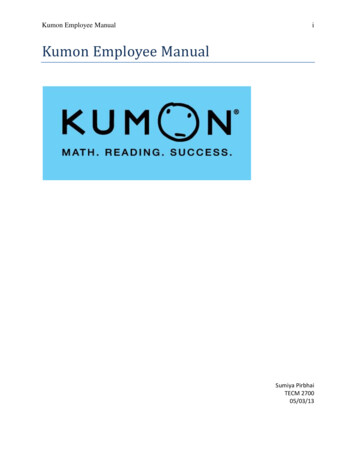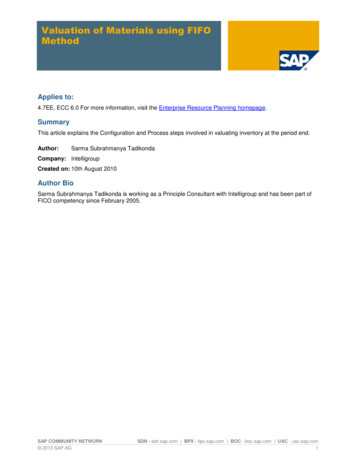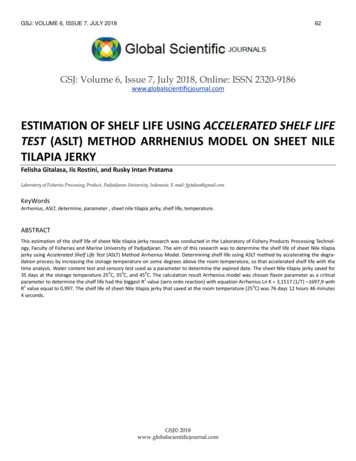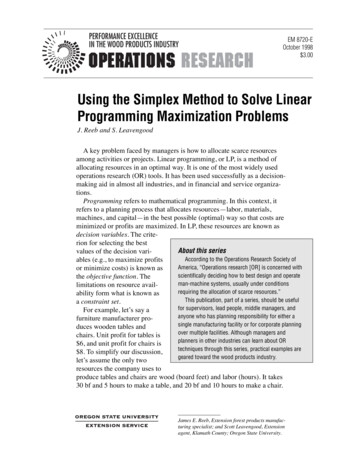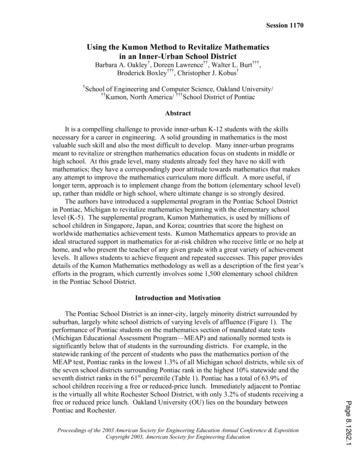
Transcription
Session 1170Using the Kumon Method to Revitalize Mathematicsin an Inner-Urban School DistrictBarbara A. Oakley†, Doreen Lawrence††, Walter L. Burt†††,Broderick Boxley†††, Christopher J. Kobus††School of Engineering and Computer Science, Oakland University/††Kumon, North America/ †††School District of PontiacAbstractIt is a compelling challenge to provide inner-urban K-12 students with the skillsnecessary for a career in engineering. A solid grounding in mathematics is the mostvaluable such skill and also the most difficult to develop. Many inner-urban programsmeant to revitalize or strengthen mathematics education focus on students in middle orhigh school. At this grade level, many students already feel they have no skill withmathematics; they have a correspondingly poor attitude towards mathematics that makesany attempt to improve the mathematics curriculum more difficult. A more useful, iflonger term, approach is to implement change from the bottom (elementary school level)up, rather than middle or high school, where ultimate change is so strongly desired.The authors have introduced a supplemental program in the Pontiac School Districtin Pontiac, Michigan to revitalize mathematics beginning with the elementary schoollevel (K-5). The supplemental program, Kumon Mathematics, is used by millions ofschool children in Singapore, Japan, and Korea; countries that score the highest onworldwide mathematics achievement tests. Kumon Mathematics appears to provide anideal structured support in mathematics for at-risk children who receive little or no help athome, and who present the teacher of any given grade with a great variety of achievementlevels. It allows students to achieve frequent and repeated successes. This paper providesdetails of the Kumon Mathematics methodology as well as a description of the first year’sefforts in the program, which currently involves some 1,500 elementary school childrenin the Pontiac School District.Introduction and MotivationProceedings of the 2003 American Society for Engineering Education Annual Conference & ExpositionCopyright 2003, American Society for Engineering EducationPage 8.1262.1The Pontiac School District is an inner-city, largely minority district surrounded bysuburban, largely white school districts of varying levels of affluence (Figure 1). Theperformance of Pontiac students on the mathematics section of mandated state tests(Michigan Educational Assessment Program—MEAP) and nationally normed tests issignificantly below that of students in the surrounding districts. For example, in thestatewide ranking of the percent of students who pass the mathematics portion of theMEAP test, Pontiac ranks in the lowest 1.3% of all Michigan school districts, while six ofthe seven school districts surrounding Pontiac rank in the highest 10% statewide and theseventh district ranks in the 61st percentile (Table 1). Pontiac has a total of 63.9% ofschool children receiving a free or reduced-price lunch. Immediately adjacent to Pontiacis the virtually all white Rochester School District, with only 3.2% of students receiving afree or reduced price lunch. Oakland University (OU) lies on the boundary betweenPontiac and Rochester.
Session 1170Figure 1: Pontiac School District, near Detroit in southeast Michigan.Table 1: Year 2000 mathematics test scores for Pontiac and surrounding schooldistricts.1MEAP*MathScores, 97.192.497.6ACT MathMeanScoreACT 21.981.8Clarkston84.492.921.878.8Lake Orion69.1---20.6---StateAverage*MEAP is the Michigan Educational Assessment Program.**SAT I and II scores unavailable from Pontiac for the year 2000.PSAT**MathMeanScore40525153PSAT**Math .283.670.186.1Page 8.1262.2Proceedings of the 2003 American Society for Engineering Education Annual Conference & ExpositionCopyright 2003, American Society for Engineering Education
Session 1170In the 2001-2002 academic year, in an effort to bring minorities into OU’sprofessional schools, Oakland implemented a pilot mathematics program in Pontiac withthe strong support and commitment of Dr. Walter Burt, Pontiac’s Superintendent ofSchools. This program is based on curriculum and methods—Kumon Mathematics—inwide use in the Asian countries that are continuously among the top scorers ininternational mathematics achievement tests.The Need for a Parallel Path in Math in an Inner-Urban School DistrictUnlike subjects such as English and geography, mathematics is an highly sequentialdiscipline. Those who ‘miss the boat’ for example, in multiplication or division will becompletely lost later, when studying fractions and decimals. Children in an inner-urbanclassroom typically span a broad range of achievement, abilities, and skills—often farmore so than in surrounding districts. Most of the commercially available textcurriculum packages make little or no allowance for large variations in achievementlevels within a given classroom or grade. Those students who are far behind grade levelmathematically are often left to fall further and further behind, because there is nomechanism for them to catch up to their peers. When enough children are in thissituation, the entire peer group suffers.The Kumon methodology outlined in this paper provides an ideal parallel path thatallows underachieving children in mathematics to catch up to the level at which theyshould be working. Simultaneously, it allows ‘super-achievers’ and normal achievers topractice, improve, and excel at their own levels. Indeed, the method by which Kumon istaught—through the use of thousands of carefully structured, logically connectedworksheets—represents an excellent individualized supplement to standard textbooks.The Kumon MethodProceedings of the 2003 American Society for Engineering Education Annual Conference & ExpositionCopyright 2003, American Society for Engineering EducationPage 8.1262.3‘Kumon’ mathematics is a methodology of enriching mathematics instruction thatwas originally developed by Toru Kumon, a Japanese mathematics teacher, as a tool tohelp his son—a second-grader who was struggling with mathematics in the 1950s. Themethod has traditionally been taught at after-school learning centers, where parents enrolltheir children on a monthly tuition basis for remediation or enrichment through asupplemental learning opportunity. Kumon complements the school curriculum withoutsimply doing ‘more of the same.’ (To support the current standards-based commercialmathematics program, Pontiac’s elementary schools currently use Houghton MifflinMath Central.) Kumon Mathematics emphasizes calculations, which the NationalTeachers of Mathematics (NCTM) has recently recognized to be a weak aspect ofAmerican teaching.2, 3 In April 2000, NCTM revealed that it learned a key lesson indeveloping its standards by stating publicly that “Students must be fluent in arithmeticcomputation – they must have efficient and accurate methods and understand them.Students should know their basic addition, subtraction, multiplication, and division.”4Kumon seeks to make computational skills automatic, leaving students with time towork on more complicated and richer connections within mathematics. As a result, suchbasic math functions are performed with little or no conscious thought.5 Wittman, et al.6believe such ‘over-learning’ reduces anxiety and point out that “students whose
Session 1170Proceedings of the 2003 American Society for Engineering Education Annual Conference & ExpositionCopyright 2003, American Society for Engineering EducationPage 8.1262.4mathematical problem-solving performance is hindered by continual need to review factsand procedures will learn to view mathematics as an anxiety-provoking experience.”As a supplementary education program, Kumon’s methods assist with improvingtest taking skills. Two factors in successful test taking are speed and accuracy, neither ofwhich have been typically taught or developed by schools. Kumon uses timingrequirements, accuracy of answers, and on-going feedback as an integral part of itsmethodology.The Kumon method uses a sequential curriculum made up of worksheets to move thestudent though a concept in small linear steps. The curriculum has 23 progressive levels,each level of which contains 20 sets, with each set consisting of 10 worksheets. Theearliest levels cover pre-counting skills, while the highest levels move through collegelevel calculus and statistics. The student moves on to the next level as mastery of theprevious level is demonstrated by meeting the timing and accuracy requirements. Kumonencourages the student to develop his or her memory, learn and store computationalprocedures, and be independent learners.After an initial placement test, students begin their Kumon experience at a levelsomewhat below their true capabilities. Students practice at this level until they cancomplete the worksheets assignments within a predetermined time limit, and with fewmistakes. This beginning level is often described at the ‘just right’ point where thestudent can become used to the routine of the program. As each student realizes successand satisfaction, motivation increases and the student is moved on to the next worksheetassignment. In the daily study routine of the Kumon method, the student experiencesmuch comfort alongside a little bit of challenge each day. In this cycle the student gainsexperience, builds confidence and develops a ‘try more’ attitude. Time and accuracy onthe end-of-level achievement tests determine whether a student is ready to move on to thenext worksheet level. Bandura15 would describe this as the “self-regulated learner.”Students are guided through the assignments, and are asked to repeat the worksheetswhere they experienced difficulty or made a number of mistakes. This activity providesthe students with what Ericsson, et al.9 calls “deliberate practice.” In effect, practicereinforces learning and provides the student with opportunities to re-learn steps he or shemay have forgotten. Research supports evidence that basic math skills mastered duringelementary grades strengthen the probability of success in the upper level mathematics.10Teacher-centered methods such as Kumon are used as an aspect of comprehensive mathinstruction in countries with high-achieving students. Repetition and practice aresignificant factors in improving student achievement, whereas reform movements such asconstructivism and discovery learning have been known to deemphasize calculation.11A basic tenet of the Kumon program is getting the correct answer as quickly aspossible. The goal for every worksheet is perfect work in standard time.Moreover, worksheets are graded as soon after completion as possible to provide studentsrapid feedback about their efforts. Kumon worksheets teach speed and accuracy,emphasizing the efficiency of learning. This approach is ideal practice for test taking.Getting the right answer quickly allows the test taker to use the newly available time fortougher or skipped questions. Also, the number sense and mental calculation that resultsfrom working the Kumon program are ideal for solving contextual problems that requirehigher-order mathematical thinking and reasoning. Benjamin Bloom12, 13 advanced theconcept that sufficient time, appropriate instruction and corrective feedback will enable
Session 117095% of the students to learn what only 20% were thought to be capable of. Kumonemploys all three elements.Kumon facilitators rely on the students’ work and success to drive student learningactivities. Facilitators become a “guide on the side” rather than the “sage on the stage.”14The instructor is urged to remain sensitive to the attitude of the student in order to assessand maintain the best balance of mastery and challenge. Using the Kumon methodology,students must correct their errors, developing self analytical skills. They use this gainedknowledge in acquiring the skill and concept on the next worksheet assignment.Ausubel16 noted that learners need long term involvement and practice “for acquiringmany skills and concepts that do not occur frequently and repetitively enough in a morenatural setting.”While most of the current 170,000 students using the Kumon method in NorthAmerica attend an after-school franchised center, Kumon has a promising history inschools as well. Approximately 7,000 students now use Kumon during regular schoolhours in Texas, Alabama, Oklahoma, and other states. With Kumon supplementing theschool-wide math program, students gain much more from their classroom instruction.Since 1990, schools have emphasized teaching toward national and state standards ineach subject area.7 As a result, in math, the focus has been on broad concepts,understanding of complex problems, and the use of calculators. The Kumon methodcomplements this instruction with the opportunity to practice and apply basic math, thusenabling students to reinforce their classroom learning in their regular mathematicscurriculum.Kumon instructors and classroom teachers have learned that students gain muchfrom structure and practice. The initial part of the Kumon curriculum is focused arounda series of worksheets that form the foundation for learning of addition, subtraction,multiplication, and division. Studies using MRI technology have found great brainactivity in the prefrontal cortex of both cerebral hemispheres when doing calculations ofadditions, subtraction, and multiplication, all of which has been found to be related to thetypes of changes seen when true mastery of a concept occurs.8The 2002-2003 Kumon Program in Pontiac and Related Programs ElsewhereProceedings of the 2003 American Society for Engineering Education Annual Conference & ExpositionCopyright 2003, American Society for Engineering EducationPage
Using the Kumon Method to Revitaliz e Mathematics in an Inner-Urban School District Barbara A. Oakley , Doreen Lawren ce , W alter L. Burt , Broderick B oxley , Christopher J. Kobus School of Engineering and Com puter Science, Oakland University/ Kum on, North Am erica/ School District of Pontiac Abstract It is a com pelling challenge to provide inner-urban K-12 students with the skills .




